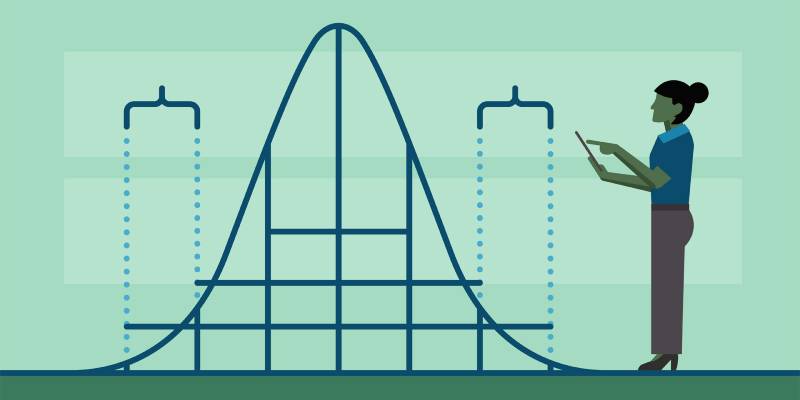Outlines how to find interquartile range (IQR) easily with a step-by-step guide nd explanation of what is the interquartile range and how you can use it.
The task of descriptive statistics is to reduce large amounts of data to a few measures in order to clearly present complex issues. One of these measures is the interquartile range.
The interquartile range is a variance parameter. The term variance parameters summarizes all statistical measures that make a statement about the distribution of individual values around the mean.
How to find frequency: absolute frequency and relative frequency
What is the interquartile range?
The interquartile range is the indication of where the “middle 50” is in a dataset. Where a range is a measure of where the beginning and end are in a set, an interquartile range is a measure of where the bulk of the values lie. That’s why it’s preferred over many other measures of spread when reporting things like salaries, school performance or SAT scores.
When looking at distributions, it is not only important to know the center of a distribution – but also to have an idea of how the values are distributed around this center. The dispersion parameters, from which we will learn about span, interquartile range, variance and standard deviation, will provide information about this. In this article, in addition to theory, we will first work through the two “simple” parameters: span and interquartile range.
How to find a correlation coefficient
How to find interquartile range (IQR) easily: Formula for interquartile range
The interquartile range formula is the first quartile subtracted from the third quartile:
IQR = Q3 – Q1
or, put differently
IQR = Q0.75 – Q0.25
- ⅠQR = Interquartile range
- Q0.75 = 0.75-quartile, 3rd quartile (Q3) or upper quartile
- Q0.25 = 0.25-quartile, 1st quartile (Q1) or lower quartile
How to find the interquartile range
In order to calculate the interquartile distance, proceed as follows:
Procedure
- Sort values in ascending order
- Calculate Quartiles
- Q3 (0.75-Quartile) -Q1 ( 0.25-Quartile)
Quartiles are special position parameters that divide a distribution into (nearing) four equal parts. For the interquartile range we need the 0.75-quartile and the 0.25-quartile.
The 0.75-quartile corresponds to the value
which is greater than or equal to 75% of all values.
Q0,75={12(X(N⋅0,75)+X(N⋅0,75+1))If N⋅0,75 IntegerX(⌈N⋅0,75⌉)If N⋅0,75 not integer
The 0.25-quartile corresponds to the value
greater than or equal to 25% of all values.
Q0,25={12(X(N⋅0,25)+X(N⋅0,25+1))If N⋅0,25 IntegerX(⌈N⋅0,25⌉)If N⋅0,25 not integer
In doing so, it is N for the number of observation values and the brackets for ⌈N⋅0,75⌉ Or. ⌈N⋅0,75⌉ stand for the rounding function. The value in parentheses may be applied to the nearest integer, which is greater than or equal to N⋅0,75 Or. N⋅0,25 rounded up.
Examples:
⌈2,8⌉=3
⌈2,3⌉=3
⌈2⌉=2
The parentheses for the rounding function ⌈X⌉ must not be used with normal square brackets [X] Confuse.
Example 1
We ask 12 children about their age.
The children’s answers are:
5, 3, 7, 4, 4, 3, 6, 4, 5, 8, 7, 5
1.) Sort values in ascending order
2.) Calculate Quartiles
In plain text format:
- 0.75-Quartile
- Q0,75={12(X(N⋅0,75)+X(N⋅0,75+1))If N⋅0,75 IntegerX(⌈N⋅0,75⌉)If N⋅0,75 not integer
- Because N=12 Applies:
- 12⋅0,75=9
- There N⋅0,75 integer, the formula for calculating the 0.75 quartile is: Q0,75=12(X(N⋅0,75)+X(N⋅0,75+1))
- With N=12 get therefore:
Q0,75=12(X(12⋅0,75)+X(12⋅0,75+1))
Q0,75=12(X9+X10)
From the table you can see X9=6 And X10=7. Consequently, the following applies:

In plain text format:
- 0.25-Quartile
- Q0,25={12(X(N⋅0,25)+X(N⋅0,25+1))If N⋅0,25 IntegerX(⌈N⋅0,25⌉)If N⋅0,25 not integer
- Because N=12 Applies:
12⋅0,25=3 - There N⋅0,25 integer, the formula for calculating the 0.25-quartile is:
Q0,25=12(X(N⋅0,25)+X(N⋅0,25+1)) - With N=12 get therefore:
Q0,25=12(X(12⋅0,25)+X(12⋅0,25+1))
Q0,25=12(X3+X4) - From the table you can see X3=4 And X4=4. Consequently, the following applies:
Q0,25=12(4+4)=12⋅8=4
3.) 0.75-Quartile – 0.25-Quartile
ⅠQR=Q0,75−Q0,25=6,5−4=2,5
The interquartile range ⅠQR is 2.5.
Example 2
We ask 11 children about their age.
The children’s answers are:
5, 3, 7, 4, 4, 3, 6, 4, 5, 7, 5
1.) Sort values in ascending order
2.) Calculate Quartiles
0.75-Quartile
Q0,75={12(X(N⋅0,75)+X(N⋅0,75+1))If N⋅0,75 IntegerX(⌈N⋅0,75⌉)If N⋅0,75 not integer
Because N=11 Applies:
11⋅0,75=8,25
There N⋅0,75 is not integer, the formula for calculating the 0.75 quartile is:
Q0,75=X(⌈N⋅0,75⌉)
With N=11 get therefore:
Q0,75=X(⌈11⋅0,75⌉)=X(⌈8,25⌉)=X9
From the table you can see X9=6. Consequently, the following applies:
Q0,75=6
0.25-Quartile
Q0,25={12(X(N⋅0,25)+X(N⋅0,25+1))If N⋅0,25 IntegerX(⌈N⋅0,25⌉)If N⋅0,25 not integer
Because N=11 Applies:
11⋅0,25=2,75
There N⋅0,25 is not integer, the formula for calculating the 0.25-quartile is:
Q0,25=X(⌈N⋅0,25⌉)
With N=11 get therefore:
Q0,25=X(⌈11⋅0,25⌉)=X(⌈2,75⌉)=X3
From the table you can see X3=4. Consequently, the following applies:
Q0,25=4
3.) 0.75-Quartile – 0.25-Quartile
ⅠQR=Q0,75−Q0,25=6−4=2
The interquartile distance ⅠQR is 2.
Outliers
The interquartile spacing can also be used to find outliers in a data set.
How to find the equation of a line
Overview of dispersion parameters
The following is an overview of some popular variance parameters .
| Span/ Range) | R.=xMax-xminR.=xMax-xmin |
| Interquartile range | I.QR.=Q0,75-Q0,25thI.QR.=Q0,75-Q0,25th |
| Mean absolute deviation/ Average absolute deviation | D.=1n⋅n∑i=1|xi-¯x| |




